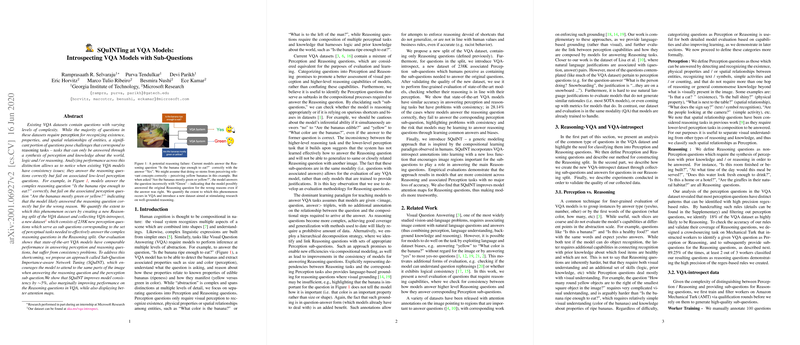Introspecting VQA Models Through Sub-Questions: An Analytical Overview
The paper "SQuINTing at VQA Models: Introspecting VQA Models with Sub-Questions" introduces a methodological advancement in the evaluation and enhancement of Visual Question Answering (VQA) systems. The authors, Selvaraju et al., emphasize the complexity within VQA tasks by distinguishing between perception and reasoning questions; a vital bifurcation for understanding and improving model capabilities.
The primary concern addressed by the paper is the consistency of VQA model responses between complex reasoning questions and their simpler perceptual counterparts. Existing datasets often mix both without distinction, failing to comprehensively evaluate a model's reasoning abilities. The authors propose a "Reasoning split," focusing on questions that require an integration of perception with logical reasoning or external knowledge. To facilitate this, they introduce VQA-introspect, a dataset containing 238,000 perception sub-questions aligned with reasoning questions in the VQA Reasoning split.
Methodology and Evaluation
The authors quantify model inconsistencies by analyzing cases where models correctly respond to reasoning questions but err on linked perception sub-questions. This discrepancy suggests that models might be using incorrect logic or dataset biases rather than genuine image comprehension to achieve high reasoning accuracy. The paper proposes Sub-Question Importance-aware Network Tuning (SQuINT) as a solution—a method that encourages attention alignment across related questions.
Empirical results highlight that current state-of-the-art VQA models, while achieving comparable success on perception and reasoning tasks, suffer significant consistency issues. For example, in 28.14% of cases where reasoning answers were correct, corresponding perception questions were answered incorrectly. SQuINT brings about a 5% improvement in model consistency, slightly boosting reasoning question performance and substantially improving attention alignment.
Practical and Theoretical Implications
Practically, this work acts as a paradigm for future VQA datasets and models to account for perceptual reasoning discrepancies more thoroughly, possibly guiding enhancements in applications like autonomous driving, robotics, and assistive technologies. Theoretically, the paper challenges researchers to develop models that are accountable not just for their outputs but for the reasoning paths they traverse, ensuring robust generalization capabilities.
Future Directions
This line of research could be extended by exploring finer subdivisions within reasoning, like separating logical reasoning from world-knowledge utilization. Furthermore, advancements in transparency and accountability of model decisions might emerge from integrating this wisdom into AI systems more broadly. Leveraging VQA-introspect and SQuINT could also lead to improved adaptive systems better suited to context-rich environments, paving the way for more nuanced AI in interactive and dynamic domains.
The paper’s emphasis on not conflating perceptual and reasoning tasks and demonstrating a method for enhancing model reasoning fidelity marks an incremental yet significant step in the journey towards more capable and trustworthy AI systems.
